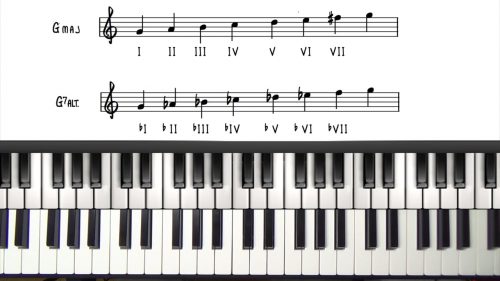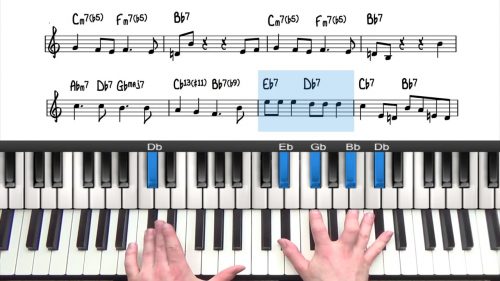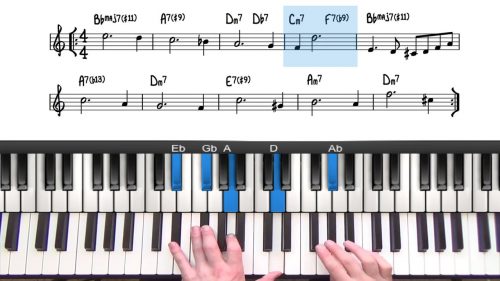Hearing & Resolving Altered Tensions
Welcome to this 5 minute masterclass on hearing and resolving altered tensions.
Altered tensions add colour and texture to our chord voicings and this has become one of the staple sounds of jazz piano. In this lesson we will work through each altered tension over dominant chords. There are only 4 of them to learn, and we will explore the colour and texture created by each of them.
Practice In The Context Of 251s
For all of the examples in this lesson, we will apply the alterations to the V7 chord in a selection of major 251s. We will pay attention to where the tension wants to resolve.
This is often just up or down a half step and being able to visualise this will create smoother transitions in your chord progressions.
b9s, #9s, #11s, & #5s
For any dominant chord, you have a choice of 4 possible altered tensions. You can combine these alterations to create more complex altered dominant sounds, but for the purpose of this tutorial we will just focus on single note alterations.
Upper Structure Triads
The information in this lesson is a nice pre-study for the concept of “Upper Structure Triads”. There is a whole PianoGroove course dedicated to this area of jazz piano which you can find in our “Intermediate Jazz Piano” courses.
The core premise behind Upper Structure Triads is that we can quickly access complex altered dominant sounds by simply remembering a handful of formulas where we superimpose triads above the dominant shell.
Practice Tips
-
When you play through each alteration, really listen to the sound it creates.
-
Each alteration creates the same 'colour' or 'texture' no matter what key you play it in.
-
In this lesson I explain how I perceive the 'colours' that are created, but it's good for you to make up your own mind on these sounds.
-
The goal is that you can aurally recognise these alterations, and make more informed choices when you apply them to your playing.







Thanks, Hayden, so neat and so useful in, for example, embellishing playing ballads in so many ways. Can’t wait for the next master class you mentioned. Smole
Brilliant – glad to hear you found it useful Smole.
And yes I must get around to that next masterclass I mentioned. It will be a synopsis of the Upper Structure Triad material on the site and I was thinking of using “Sophisticated Lady” to demonstrate the concepts. A beautiful tune and great for applying UST harmony. I will get around to that lesson shortly.
It’s fun trying to condense larger parts of the syllabus into these shorter style of lesson. Plenty more to come!
Cheers,
Hayden
More than just useful (is there such a construction in English), the more I spend time experimenting with II-V-I and USTs. And, since you mentioned it, I immediately listened to Hank Jones’ rendition of “Sophisticated Lady” that reminded me why it is high on my bucket list: the challenge of the bridge that I cannot wait to ‘get’ (I find it difficult but will get there). Pls. do not rush on my account with your plans using the tune, plenty to do to get there.
Thanks again, Smole
P.S. I forgot, Tuomo’s master class on Advanced Improvisation Concepts is, I think, brilliant (and said so in the comments section) and so very useful here, too. I am taking his guidance on doing the most difficult task “take it around all 12 keys!” (a phrase, I am sure, many of us students simply shudder when heard).